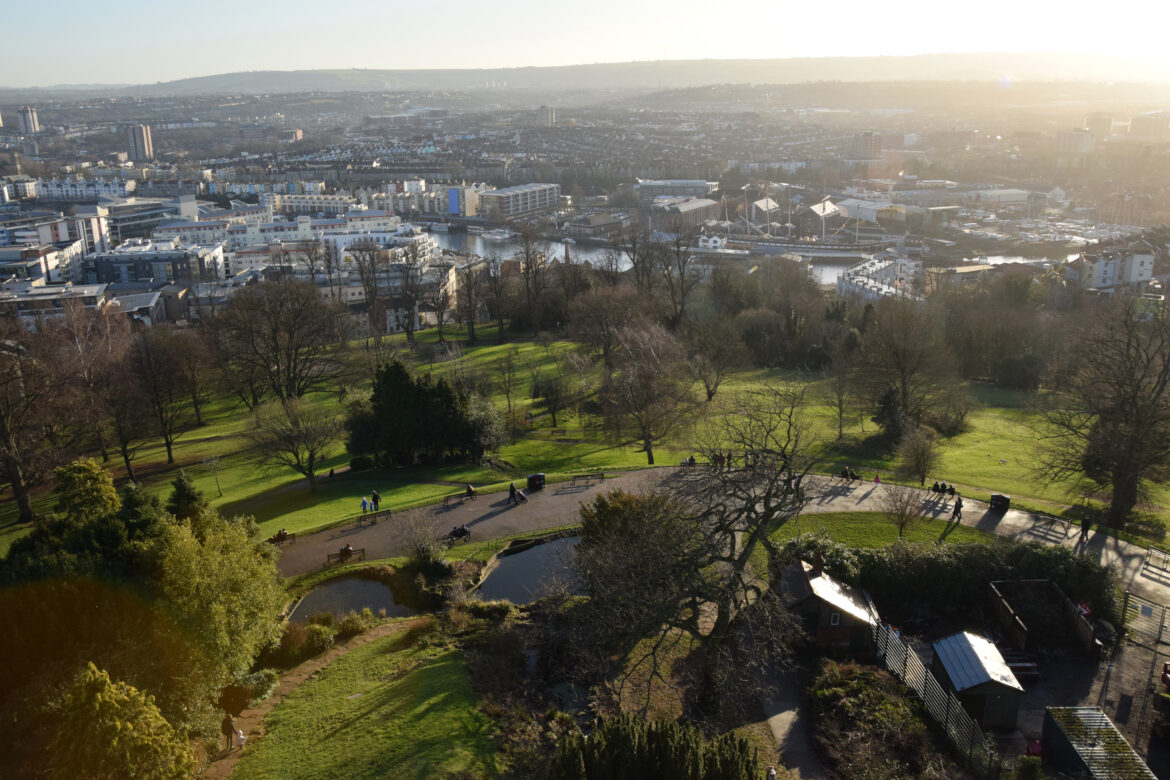Tucked immediately west of the city centre, Brandon Hill feels a little like Bristol’s green thinking cap: small, steep, and full of ideas. At just a few hectares it isn’t a wilderness, but it’s one of those urban places that manages to be both a peaceful pocket of nature and a place layered with history, views and community. For anyone visiting Bristol — or for locals who need a quick escape from traffic and shops — Brandon Hill is an easy, characterful stop worth lingering at.
A hill with stories
Brandon Hill is often described as Bristol’s oldest park: its public use stretches back many centuries, with land associated with the town from medieval times and recorded uses evolving from grazing and hay-making to the formal public park that exists today. The hill itself was an important defensive position during the Civil War and you can still sense those older layers beneath the lawns and paths. On the summit stands Cabot Tower, built in 1897 to commemorate John Cabot’s voyage of 1497 — the tower is one of the hill’s most recognisable features and rewards the climb with wide views over Bristol.
What to expect on a visit
Approach Brandon Hill from the Harbourside, Park Street or Hotwells and you’ll notice how the streets funnel up into the park: the slopes are steep in parts, which makes the summit feel like a real achievement even though the hill is compact. The park is a mix of open grassland, informal gardens, and a small but well-managed nature reserve that sits on the upper slopes. Winding paths, a modest pond, benches tucked among shrubs and the red-brick silhouette of Cabot Tower give the place an intimate, compact atmosphere that changes with the seasons. Admission is free and the park is open at all times, making it easy to pop in for a sunrise, a lunch break or a late-afternoon wander.
The nature reserve and wildlife
The upper part of Brandon Hill contains a two-hectare nature reserve that has been stewarded for decades by the Avon Wildlife Trust. It’s small but surprisingly rich: wildflower meadows burst into colour in summer with ox-eye daisies, cowslips and knapweed; the pond provides a breeding spot for frogs and toads; and the reserve attracts passerine birds, small mammals and bats that forage around dusk. The compact size of the reserve means wildlife can be easily observed without long walks — perfect for photographers, families, or anyone who wants accessible nature in the middle of the city.
Plants, insects and seasonal highlights
If you visit in spring you’ll find early bulbs and a flush of new leaves; by late spring and summer the meadow areas hum with pollinators — bees, hoverflies and a variety of butterflies — taking advantage of the wildflowers. Autumn brings a warm palette to the trees and shrubs, and winter exposes the hill’s topography and city views more clearly when the leaf cover thins. For people interested in wild food or botany, local events and foraging walks are sometimes organised on and near the hill — a reminder that urban green spaces can be learning spaces as well as places to relax. brandonhillnature.wordpress.com
Cabot Tower — postcard views
No write-up of Brandon Hill is complete without mentioning Cabot Tower. The Victorian tower rises from the summit and can be climbed when open, offering panoramas across the Bristol skyline and the Avon Gorge. The tower’s presence gives the park a focal point: it’s a great photographic subject, a navigational landmark for exploring the city and a slice of civic pride. Visitors often time their visits for clear days when the views are at their best. visitbristol.co.uk+1
Community and conservation
Brandon Hill benefits from active community involvement. The “Friends of Brandon Hill” group, along with the Avon Wildlife Trust and Bristol parks volunteers, run conservation tasks, habitat management and community events — everything from meadow maintenance to guided walks and wildlife surveys. That local stewardship is a big part of why the reserve punches above its weight: volunteers help maintain habitat diversity and provide nature education for the public. If you like to get involved, there are regular volunteer sessions and occasional workshops that welcome newcomers. facebook.com+1
Practical tips
- Getting there: The hill is within easy walking distance of Bristol city centre and the Harbourside. Steep approaches mean you’ll get a short workout; there are paths for most fitness levels but bring sensible shoes for slippery weather.
- Facilities: There are benches, paths and public toilets nearby; the hill itself is small so facilities are limited compared to large parks. Plan refreshments if you’re staying a while.
- Accessibility: The slopes can be steep; some routes are more accessible than others, but check local access guides if mobility is a concern.
- Best time to visit: For wildflowers and pollinators, late spring–summer. For crisp city panorama photos, choose autumn or winter mornings when air is clearer.
Why Brandon Hill matters
It’s easy to underestimate small urban nature spots, but Brandon Hill is a concentrated example of how history, wildlife and civic life can share a small space. You get the sense that the hill has always been a resource for Bristol — from grazing and defence to public recreation and nature conservation — and today it functions beautifully as a pocket-sized nature reserve, a viewpoint and a community hub. Its steep lawns, pond and tower make a short visit feel like an outing, and the presence of committed volunteers and the Avon Wildlife Trust means its nature value is actively maintained.
Wrapping up
Whether you’re a visitor filling a half-day of sightseeing or a local needing a short reset, Brandon Hill is worth the climb. Pack a camera, take the paths slowly, look for meadow flowers and pond life, and find a bench to enjoy the view towards the Avon Gorge and beyond. Small parks can have outsized character — Brandon Hill is proof of that.

